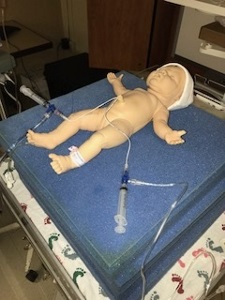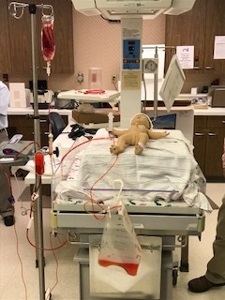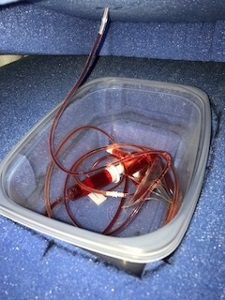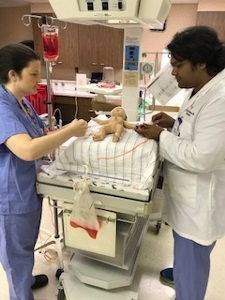HomeGrown Solution: Neonatal Exchange Transfusion Trainer
Title
Submitted By
HomeGrown Solution Number
Identification of the Problem
Unique Idea
Objectives
Supplies/Ingredients
- Repurposed neonatal manikin
- Umbilical Vessel Catheters
- 50mL spiked IV bag
- Tygon flexible polymer tubing (1/16” ID)
- Foam block (16.5”x16.5”x2”)
- Plastic Tupperware container
Steps to Creating the Solution
- Four foam blocks were used to disguise the fluid reservoir as the patient’s bed. The two middle blocks were carved out for a plastic container to hold the spiked IV bag.
- The container and IV bag create the fluid reservoir, which acts as the neonate’s blood supply.
- The umbilical catheters were run through the neonate and inserted into the Tygon tubing. A separate system was created for the two different methods of exchange transfusion. A small Y-connection splitter allowed for the inclusion of the two catheter design.
- The umbilical catheters were connected to the fluid reservoir by a luer lock connection. This allowed for the ability to easily swap between exchange transfusion methods.
Images
HomeGrown Disclaimer
The information contained within this website is for information purposes only. While the website is monitored in an attempt to keep the information up to date and accurate, be aware that there are no representations or warranties of any kind, express or implied, about the completeness, accuracy, reliability, and/or suitability being made. The sponsors of this website are not liable for any loss or damage that may result from using information contained within this website. Any reliance you place on the information contained within this website is strictly at your own risk.
Please note that sections of this website include postings of individuals not associated with the website sponsors. These postings are not endorsed or warrantied by the website, and use of such information is at your own risk.
Always check the user guide/manuals provided by the manufacturer of your manikin or task trainer. Using products that are not sanctioned may invalidate the product warranty. (For example: Some products could stain the skin on a manikin. Liquids used around electrical parts may cause malfunctions.)





